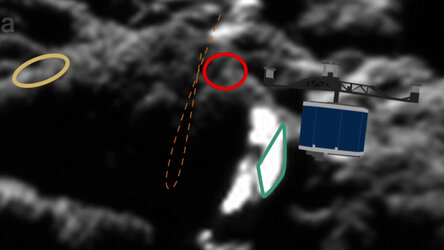Accept all cookies Accept only essential cookies See our Cookie Notice

About ESA
The European Space Agency (ESA) is Europe’s gateway to space. Its mission is to shape the development of Europe’s space capability and ensure that investment in space continues to deliver benefits to the citizens of Europe and the world.
Highlights
ESA - United space in Europe
This is ESA ESA facts Member States & Cooperating States Funding Director General Top management For Member State Delegations European vision European Space Policy ESA & EU Space Councils Responsibility & Sustainability Annual Report Calendar of meetings Corporate newsEstablishments & sites
ESA Headquarters ESA ESTEC ESA ESOC ESA ESRIN ESA EAC ESA ESAC Europe's Spaceport ESA ESEC ESA ECSAT Brussels Office Washington OfficeWorking with ESA
Business with ESA ESA Commercialisation Gateway Law at ESA Careers Cyber resilience at ESA IT at ESA Newsroom Partnerships Merchandising Licence Education Open Space Innovation Platform Integrity and Reporting Administrative Tribunal Health and SafetyMore about ESA
History ESA Historical Archives Exhibitions Publications Art & Culture ESA Merchandise Kids Diversity ESA Brand Centre ESA ChampionsLatest
Space in Member States
Find out more about space activities in our 23 Member States, and understand how ESA works together with their national agencies, institutions and organisations.
Science & Exploration
Exploring our Solar System and unlocking the secrets of the Universe
Go to topicAstronauts
Missions
Juice Euclid Webb Solar Orbiter BepiColombo Gaia ExoMars Cheops Exoplanet missions More missionsActivities
International Space Station Orion service module Gateway Concordia Caves & Pangaea BenefitsLatest
Space Safety
Protecting life and infrastructure on Earth and in orbit
Go to topicAsteroids
Asteroids and Planetary Defence Asteroid danger explained Flyeye telescope: asteroid detection Hera mission: asteroid deflection Near-Earth Object Coordination CentreSpace junk
About space debris Space debris by the numbers Space Environment Report In space refuelling, refurbishing and removingSafety from space
Clean Space ecodesign Zero Debris Technologies Space for Earth Supporting Sustainable DevelopmentApplications
Using space to benefit citizens and meet future challenges on Earth
Go to topicObserving the Earth
Observing the Earth Future EO Copernicus Meteorology Space for our climate Satellite missionsCommercialisation
ESA Commercialisation Gateway Open Space Innovation Platform Business Incubation ESA Space SolutionsEnabling & Support
Making space accessible and developing the technologies for the future
Go to topicBuilding missions
Space Engineering and Technology Test centre Laboratories Concurrent Design Facility Preparing for the future Shaping the Future Discovery and Preparation Advanced Concepts TeamSpace transportation
Space Transportation Ariane Vega Space Rider Future space transportation Boost! Europe's Spaceport Launches from Europe's Spaceport from 2012Latest

How Philae left its mark during touchdown two
Thank you for liking
You have already liked this page, you can only like it once!
This graphic presents the data collected by Philae’s ROMAP instrument – a magnetometer boom – during the time of the second touchdown on Comet 67P/Churyumov-Gerasimenko on 12 November 2014, matched with imagery showing evidence of the key moments of Philae’s interaction with the surface.
Signatures were created in the magnetic data of the ROMAP boom relative to the lander body when the boom physically moved as it struck a surface (the boom sticks out 48 cm from the lander body). This created a characteristic set of spikes in the magnetic data, which provided an estimate of the duration of Philae stamping into the ice. The data could also be used to constrain the acceleration of Philae during these contacts. The data shows that Philae spent nearly two full minutes at touchdown site two, making contact with the surface multiple times.
The data plot is labelled with five different events, corresponding to the imagery. Initially travelling in a downward direction, Philae slides down the edge of a boulder (1) and flips vertically, rotating like a windmill to pass between two boulders (2) exposing layers of ice in the crevice walls with its feet. A dust wall was created by the windmill action, pushing through the dust that had heaped up between the boulders up to that point in time. The crevice is about 2.5 m long and is curved with a width of 1-1.5 m, allowing Philae to pass through. Philae then stamps a 25 cm imprint of the top of the lander into the comet’s surface (3) – a hole made by the top of the SD2 (Sampling, Drilling and Distribution device) tower that sticks up above the top of Philae can be recognised. Philae then climbed out of the crevice, being pushed down once more by an overhang (4a), knocking off material in the process, with its top surface then creating an impression in the dust corresponding to the ‘eye’ of the feature that resembles a skull face (4b).
The ROMAP data also reveal information about the speed and direction of travel. When Philae first entered the region it was travelling downwards at 20 cm/s and forwards at 10 cm/s. When it left the area it was travelling upwards at less than 1 cm/s and forwards at 9 cm/s. It never flew higher than one metre above the surface in its final flight to touchdown point three, 30 m away.
See Philae’s dance at touchdown two animated infographic to visualise the motion.
-
CREDIT
Images: ESA/Rosetta/MPS for OSIRIS Team MPS/UPD/LAM/IAA/SSO/INTA/UPM/DASP/IDA; Data: ESA/Rosetta/Philae/ROMAP; Analysis: O’Rourke et al (2020) -
LICENCE
ESA Standard Licence

Philae’s dance at touchdown two

Reconstructing Philae’s trajectory

Rosetta and Philae investigate magnetic properties o…

Reconstructing Philae’s flight















 Germany
Germany
 Austria
Austria
 Belgium
Belgium
 Denmark
Denmark
 Spain
Spain
 Estonia
Estonia
 Finland
Finland
 France
France
 Greece
Greece
 Hungary
Hungary
 Ireland
Ireland
 Italy
Italy
 Luxembourg
Luxembourg
 Norway
Norway
 The Netherlands
The Netherlands
 Poland
Poland
 Portugal
Portugal
 Czechia
Czechia
 Romania
Romania
 United Kingdom
United Kingdom
 Slovenia
Slovenia
 Sweden
Sweden
 Switzerland
Switzerland

























